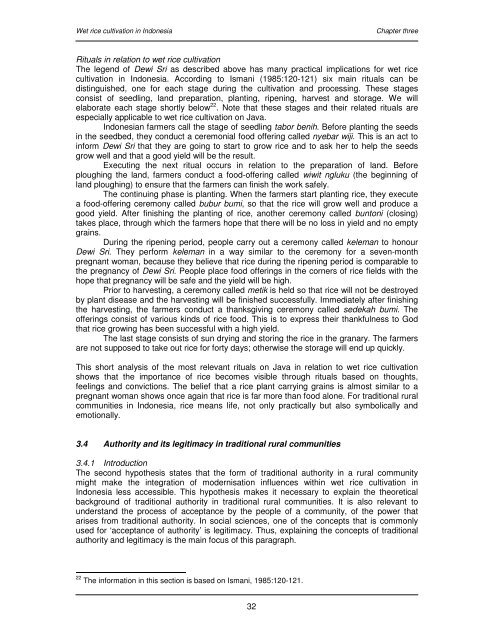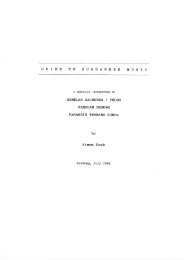Wet rice cultivation in Indonesia - Free EBooks Library
Wet rice cultivation in Indonesia - Free EBooks Library
Wet rice cultivation in Indonesia - Free EBooks Library
You also want an ePaper? Increase the reach of your titles
YUMPU automatically turns print PDFs into web optimized ePapers that Google loves.
<strong>Wet</strong> <strong>rice</strong> <strong>cultivation</strong> <strong>in</strong> <strong>Indonesia</strong> Chapter three<br />
Rituals <strong>in</strong> relation to wet <strong>rice</strong> <strong>cultivation</strong><br />
The legend of Dewi Sri as described above has many practical implications for wet <strong>rice</strong><br />
<strong>cultivation</strong> <strong>in</strong> <strong>Indonesia</strong>. Accord<strong>in</strong>g to Ismani (1985:120-121) six ma<strong>in</strong> rituals can be<br />
dist<strong>in</strong>guished, one for each stage dur<strong>in</strong>g the <strong>cultivation</strong> and process<strong>in</strong>g. These stages<br />
consist of seedl<strong>in</strong>g, land preparation, plant<strong>in</strong>g, ripen<strong>in</strong>g, harvest and storage. We will<br />
elaborate each stage shortly below 22 . Note that these stages and their related rituals are<br />
especially applicable to wet <strong>rice</strong> <strong>cultivation</strong> on Java.<br />
<strong>Indonesia</strong>n farmers call the stage of seedl<strong>in</strong>g tabor benih. Before plant<strong>in</strong>g the seeds<br />
<strong>in</strong> the seedbed, they conduct a ceremonial food offer<strong>in</strong>g called nyebar wiji. This is an act to<br />
<strong>in</strong>form Dewi Sri that they are go<strong>in</strong>g to start to grow <strong>rice</strong> and to ask her to help the seeds<br />
grow well and that a good yield will be the result.<br />
Execut<strong>in</strong>g the next ritual occurs <strong>in</strong> relation to the preparation of land. Before<br />
plough<strong>in</strong>g the land, farmers conduct a food-offer<strong>in</strong>g called wiwit ngluku (the beg<strong>in</strong>n<strong>in</strong>g of<br />
land plough<strong>in</strong>g) to ensure that the farmers can f<strong>in</strong>ish the work safely.<br />
The cont<strong>in</strong>u<strong>in</strong>g phase is plant<strong>in</strong>g. When the farmers start plant<strong>in</strong>g <strong>rice</strong>, they execute<br />
a food-offer<strong>in</strong>g ceremony called bubur bumi, so that the <strong>rice</strong> will grow well and produce a<br />
good yield. After f<strong>in</strong>ish<strong>in</strong>g the plant<strong>in</strong>g of <strong>rice</strong>, another ceremony called buntoni (clos<strong>in</strong>g)<br />
takes place, through which the farmers hope that there will be no loss <strong>in</strong> yield and no empty<br />
gra<strong>in</strong>s.<br />
Dur<strong>in</strong>g the ripen<strong>in</strong>g period, people carry out a ceremony called keleman to honour<br />
Dewi Sri. They perform keleman <strong>in</strong> a way similar to the ceremony for a seven-month<br />
pregnant woman, because they believe that <strong>rice</strong> dur<strong>in</strong>g the ripen<strong>in</strong>g period is comparable to<br />
the pregnancy of Dewi Sri. People place food offer<strong>in</strong>gs <strong>in</strong> the corners of <strong>rice</strong> fields with the<br />
hope that pregnancy will be safe and the yield will be high.<br />
Prior to harvest<strong>in</strong>g, a ceremony called metik is held so that <strong>rice</strong> will not be destroyed<br />
by plant disease and the harvest<strong>in</strong>g will be f<strong>in</strong>ished successfully. Immediately after f<strong>in</strong>ish<strong>in</strong>g<br />
the harvest<strong>in</strong>g, the farmers conduct a thanksgiv<strong>in</strong>g ceremony called sedekah bumi. The<br />
offer<strong>in</strong>gs consist of various k<strong>in</strong>ds of <strong>rice</strong> food. This is to express their thankfulness to God<br />
that <strong>rice</strong> grow<strong>in</strong>g has been successful with a high yield.<br />
The last stage consists of sun dry<strong>in</strong>g and stor<strong>in</strong>g the <strong>rice</strong> <strong>in</strong> the granary. The farmers<br />
are not supposed to take out <strong>rice</strong> for forty days; otherwise the storage will end up quickly.<br />
This short analysis of the most relevant rituals on Java <strong>in</strong> relation to wet <strong>rice</strong> <strong>cultivation</strong><br />
shows that the importance of <strong>rice</strong> becomes visible through rituals based on thoughts,<br />
feel<strong>in</strong>gs and convictions. The belief that a <strong>rice</strong> plant carry<strong>in</strong>g gra<strong>in</strong>s is almost similar to a<br />
pregnant woman shows once aga<strong>in</strong> that <strong>rice</strong> is far more than food alone. For traditional rural<br />
communities <strong>in</strong> <strong>Indonesia</strong>, <strong>rice</strong> means life, not only practically but also symbolically and<br />
emotionally.<br />
3.4 Authority and its legitimacy <strong>in</strong> traditional rural communities<br />
3.4.1 Introduction<br />
The second hypothesis states that the form of traditional authority <strong>in</strong> a rural community<br />
might make the <strong>in</strong>tegration of modernisation <strong>in</strong>fluences with<strong>in</strong> wet <strong>rice</strong> <strong>cultivation</strong> <strong>in</strong><br />
<strong>Indonesia</strong> less accessible. This hypothesis makes it necessary to expla<strong>in</strong> the theoretical<br />
background of traditional authority <strong>in</strong> traditional rural communities. It is also relevant to<br />
understand the process of acceptance by the people of a community, of the power that<br />
arises from traditional authority. In social sciences, one of the concepts that is commonly<br />
used for ‘acceptance of authority’ is legitimacy. Thus, expla<strong>in</strong><strong>in</strong>g the concepts of traditional<br />
authority and legitimacy is the ma<strong>in</strong> focus of this paragraph.<br />
22 The <strong>in</strong>formation <strong>in</strong> this section is based on Ismani, 1985:120-121.<br />
32








